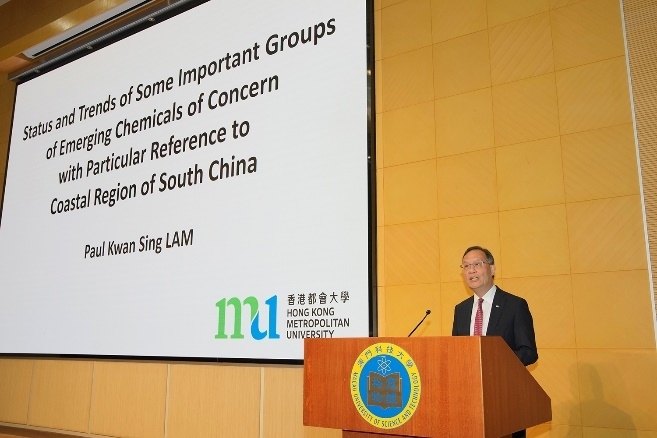A talk by Prof. Paul LAM Kwan-sing entitled “Status and Trends of Some Important Groups of Emerging Chemicals of Concern with Particular Reference to Coastal Region of South China” was successfully held online and offline on April 19th, 2023, at the N101 Auditorium of the Library Building, as part of Macau University of Science and Technology (M.U.S.T.) talk sessions with prominent scientific figures. Prof. Paul LAM Kwan-sing, President of Hong Kong Metropolitan University and a famous expert in environmental chemistry, was invited to this lecture as a guest speaker. Chair Prof. Joseph Hun-wei LEE, President of M.U.S.T. welcomed and thanked Prof. Paul LAM Kwan-sing with an opening greeting.

Prof. Paul LAM Kwan-sing
Prof. Lam began by introducing the coverage of emerging organic pollutants, which may include pharmaceuticals and personal care products, endocrine disrupting chemicals, per- and polyfluoroalkyl substances (PFAS), halogenated flame retardants (HFRs) and disinfection by-products, pathogens; and viruses and other biologically or chemically active macromolecules may also be included. This leads to the grease, oil, and water resistance of fluorine-containing surfactants. Prof. Lam discussed the characteristics of the general distribution of emerging organic pollutants through the comparison of the pollution degree of PFASs in HPLC-MS/MS and the comparison before and after improvement. He then introduced the relevant research data and showed the distribution of PFASs in the South China Sea. Based on this topic, he proposed that PFASs affect the lives of local water birds and cetaceans, and the trend of the impact is increasing. According to Prof. Lam, scientists analyzed potential pollutants based on data collected from the food of dolphins and water birds to find out the pollutants can cause great harm to the environment and bioenergy, emphasizing that emerging organic pollutants represent a serious and global threat.
After that, Prof. Lam explained the chemical composition of another emerging organic pollutant, halogenated flame retardants. By comparing the HFRs content in the Pearl River Delta and the Yangtze River Delta, he concluded that the pollution in the two regions is significantly different. Furthermore, he said that there are many chemical substances in the world, but due to insufficient data and the inability to assess risks, only 80,000 to 100,000 chemical substances have been known to humans and are being used worldwide. Prof. Lam also reminded students to try and simplify the complex issues in research and promote efficient progress of the research.
At the end of the lecture, Prof. Lam introduced scientifically based environmental risk assessment actions and suggested that to speed up this action, people should maintain and manage the environment together, while keeping the earth clean. Meanwhile, he also encouraged students to devote themselves to studying, researching, and contributing to finding solutions to environmental problems.





